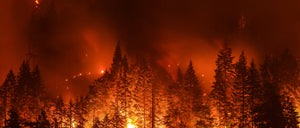As the climate gets warmer, we can expect increases in the number, size, and duration of wildfires.
Wildfire smoke represents a serious public health threat due to its main component which is particle pollution. Particle pollution (also known as particles, particulate matter, or PM) is just a general catch-all term for solid and liquid droplets in the air. While there are many sources of it, combustion-related activities like wildfires are the most common. There are all sorts of components making up particle pollution such as acids, inorganic compounds, organic chemicals, soot, metals, soil or dust particles, and biological materials.
We are constantly breathing in particle pollution, but it increases to dangerous levels during wildfires or combustion-related activities. The particles to be most concerned about are smaller than 10 micrometers in diameter because they can pass through the nose and throat into the lungs.
The best way to protect your health is to reduce your exposure to wildfire smoke. There are many practical ways to prevent particle pollution from wildfire smoke from entering your indoor space. Read our tips on how to protect yourself from smoke inhalation:
1. Invest in an air purifier
You may wish to purchase an air purifier with a HEPA filter to remove the fine particles from your air. At UV CAN Sanitize, our Tulip and Azalea-02 air purifiers are equipped with a HEPA filter and activated carbon filter. The activated carbon filter also helps to eliminate the smoke odour from the room. Make sure to run them as often as possible on the highest speed. It is important to choose an air purifier that is the right size for your indoor space:
TULIP HEPA Air Purifier |
AZALEA-02 HEPA Air Purifier |
 |
 |
|
Tulip is the best portable air purifier for your home or your desk in the office as it purifies the air at a rate of 41 to 65 ft³ per minute. |
Azalea-02 cleans the air at a rate of 1177 ft³ per minute making it best for your large office space, boardroom, waiting room, or reception area. |
2. Keep doors and windows in your home closed
This is one of the main ways that smoke can enter from outdoors. Watch indoor temperatures on hot days because heat can be dangerous as well. Be sure to check in on people who are elderly or with underlying heath conditions that could make them vulnerable to the heat. Remember to stay well-hydrated.
3. Avoid using the dryer and hood vents
Dryers and hood vents can suck in smokey air from outside through the vent hose. To dry your clothes, you should hang them up inside on a rack. If you are going to avoid using the hood vent, avoid frying and broiling or try to cook food that uses lower heat to avoid more smoke indoors.
4. Block underneath of doors with a damp towel
Even when you keep doors closed, there is still a gap between the bottom of the door and the frame for smoke to enter your house and spread between rooms. A cost-effective method is to use some spare damp towels or rags to block the gap. The dampness prevents more air from passing through
5. Use sealant strips around windows
People usually use weather strips to stop cold air from coming inside and causing drafts during the winter. If you have any drafty areas, you can also use them to prevent smoke in the air from entering in through the cracks. There are several different types to make your home airtight.
6. Set your HVAC system to recirculation mode
If your HVAC system uses fresh air intake, close the outdoor intake damper or set the system to recirculate mode.
7. Avoid other activities that create indoor particle pollution
Even if you are taking the precautions to keep smoke from entering from outside, you will still need to reduce creating particle pollution inside. Some activities that make indoor air quality worse are: smoking cigarettes; using gas, propane or wood-burning stoves and furnaces; spraying aerosol products; frying or broiling food; burning candles or incense; vacuuming (unless your vacuum has a HEPA filter)
8. Re-locate to an indoor space with cleaner air
It may be best to re-locate to libraries, community centers, or other public spaces that use central air conditioning for cleaner air. You should do this especially on hot days or if you are particularly vulnerable to adverse wildfire smoke health effects.
It is important to especially check in on people who are most at risk for negative health effects from wildfire smoke. This can include people with cardiovascular or respiratory disease, older adults, children under 18 years of age, pregnant women, outdoor workers, and those of lower socio-economic status.
Wildfire smoke results in some of the worst air quality that we can face here in Canada. It is always good to be prepared and have a plan to avoid as much exposure as possible.
If you are wondering how to purify air from wildfire smoke by incorporating a portable air purifier into your plan, we recommend our HEPA air purifiers, Tulip and Azalea-02 for your home or workplace respectively.

